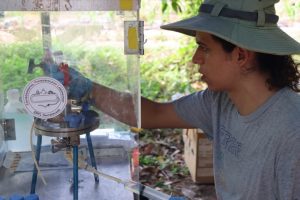Arsenic biogeochemistry
There are two major projects ongoing at EML. One on arsenic microbial methylation and another on microbial arsenic transformations in a Mekong Delta aquifer.
Microbial arsenic methylation
 |
 |
Arsenic is a ubiquitous and non-threshold carcinogenic element. In this study, we aim to unravel the bacterial biochemical steps leading to the formation of organic arsenic compounds by combining state-of-the-art analytical speciation techniques with microbiological and molecular biology tools. This work will allow a better understanding of its biogeochemical cycle and may lead to direct applications for the bioremediation of arsenic polluted sites.
As arsenic methylation is enhanced under anoxic conditions, it is crucial to identify the microorganisms responsible for this process and to decipher the underlying mechanism and regulation of arsenic methylation.
The major goals of this work are: (a) to isolate elusive arsenic methylating and demethylating anaerobic microorganisms; (b) decipher the mechanistic underpinnings of the methylation; (c) unravel the ecological role of anaerobic arsenic methylation, which results in the formation of a more toxic form of arsenic than the substrate.
People: Hugo Sallet (Ph.D. student), NN (Ph.D. student)
Collaboration: within NCCR Microbiomes
Funding: NCCR Microbiomes, SNSF
Microbial arsenic transformations in a Mekong Delta aquifer
 |
 |
Arsenic (As) release from sediments into groundwater is a major water quality problem in South and South-East Asia. The currently accepted mechanism of release of arsenic is through microbially driven reductive dissolution of iron oxy(hydr)oxides as a result of organic matter input. However, the seasonal geochemical behavior of reduced iron and arsenic (i.e., their release) is not consistent with other geochemical indicators (e.g., nitrate and sulfate increase). Therefore, this project investigates the biogeochemical and hydological dynamics of a 5-well transect in the Mekong Delta in Vietnam
This project combines techniques and approaches from mineralogy and geochemistry to characterize the groundwater composition as well as the chemistry and the mineralogy of the soil (using electron microscopy, x-ray diffraction and x-ray fluorescence) and As speciation (HPLC-ICP-MS) to determine the main sources and sinks of As in the sediments. However, the focus is on microbiology by leveraging meta-omics to decipher seasonal variations in microbial activity and their impact on geochemistry.

People: Juan Pablo Marin Jaramillo (Ph.D. student), Manon Frutschi (Technician)
Collaboration: Quang Khai Ha and Phu Le Vo (Ho Chi Minh City University of Technology)
Funding: SNSF